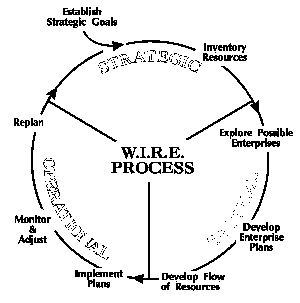DossierCourse/Program Description |
![]()
Course/Program Description
During the 1980s Total Ranch Management (TRM)—an integrated, systems approach to management of agricultural operations—was developed by the Texas Cooperative Extension Service. This effective program was offered across Texas and is the cornerstone for development of the WIRE (Western Integrated Resource Education) course.
After attending a TRM workshop in 1990, Wyoming has expanded, refined and adapted the TRM materials for greater applicability to Northern prairie and mountain regions. In 1995 a Sustainable Agriculture Research and Education (SARE) grant funded team-training and expansion of the WIRE program to Montana and Utah (SARE #95-036) and in 1997 to Idaho (SARE #97-035). To date, 18 WIRE programs (10 by the Wyoming team) have been offered across participating western states reaching a total of 426 participants. In addition, over 45 faculty have been trained and are offering the program in the region.

The WIRE program teaches a systems-based process for integrating management of the physical, biological, financial, and human resources of agriculture operations. Operators are taught the WIRE process—to set and prioritize goals, inventory resources, evaluate potential enterprises and develop enterprise plans, implement plans, and monitor subsequent progress toward goals. These are skills that allow participants to objectively assess all components of their agriculture operations as a system. In this way it helps graduates manage their operations in today’s environment of transition and change.
The course is taught by an interdisciplinary team, provides hands on experience, and includes field trips/labs. A focused, well coordinated, team-teaching method is used for course instruction. All presentations are related to previously presented material and to the general WIRE process, so as to build-on and better integrate the information presented. In addition, core instructors representing ag economics, animal science and agronomy/range science remain present throughout the course to handle questions as they arise and to provide continuity to course delivery.
In-depth case-studies have been extensively tested and used through repeated offerings of WIRE courses in the western states. These 6-year case-studies are based upon physical acreage, water development, and environmental data (elevation, precipitation, etc.) of actual western ranches. Forage, livestock, financial, and wildlife resource information are based on historic stocking levels, market values, and environmental conditions. Human resource documentation was developed to accompany the other resource descriptions.
The case-studies serve to represent typical ranch operations found in the region. As such, they provide course participants a factual situation with which to practice application of the WIRE management process, without the requirement of having their own data. In addition, a recently produced case study video helps portray the difficult challenges faced by today’s producers, as well as how an integrated management process might help them discover solutions.
The Wyoming team has provided project leadership to this point, with the Wyoming WIRE coordinator also coordinating the regional effort. A Regional WIRE Coordinating Committee has facilitated coordination and assistance to state teams as they modifying WIRE materials to make them more applicable to the individual states. This has helped ensure consistency of materials with the broader Western regional program.
The Wyoming team also serves in an advisory capacity for other WIRE teams as they prepare to offer the program. Interdisciplinary teaching teams patterned after the Wyoming team typically include people trained in the following areas: livestock, agronomy/range, agricultural economics, and human resources. People with expertise in forestry, wildlife and other resource management areas are utilized as needed.
The teaching teams are responsible for teaching the WIRE process to primarily to ranchers/farmers.
WIRE courses are typically formatted as follows: a) producers participate in a five to six-day course at each location; b) subject matter is taught using a variety of techniques, including individual and team lectures, hands-on problem sets illustrating both theoretical and practical management situations, role plays, written materials and two field trips/labs providing hands-on experience with some of the management techniques presented.
Participants work both as individuals and in "management teams" with other course participants when completing problem sets. Students learn to apply the WIRE process, utilize WIRE worksheets, as well as financial calculators and computers, for analysis, planning, budgeting and record keeping. Lecture sections are presented using overhead transparencies, slides, video tapes, computers, and other tools.
Participants also receive and learn to utilize a large reference notebook composed of over 150 research-based articles, extension bulletins and other written materials divided into sections on each ranch/farm resource. The resource areas presented/discussed in the Reference Book include: wildlife; human, financial, livestock, and basic resources- natural and basic resources- agronomic. This notebook contains sources and order blanks for additional resource information and stands as a cornerstone for follow up information for participants.
Three in-depth, resource/discipline-specific follow up programs have also been developed in Wyoming. These programs cover financial management, rangeland monitoring, and marketing/risk management. A farm version of the original course was also formulated.
A copy of the WIRE Workbook has also been included at the end of this section. The workbook provides an overview of the WIRE process in the introduction, an explanation of each resource category, as well as examples of the WIRE worksheets. As such it should provide the reader with a general understanding of the material presented in the WIRE course.
 Back to the WIRE Dossier Table
of Contents Page
Back to the WIRE Dossier Table
of Contents Page
![]()